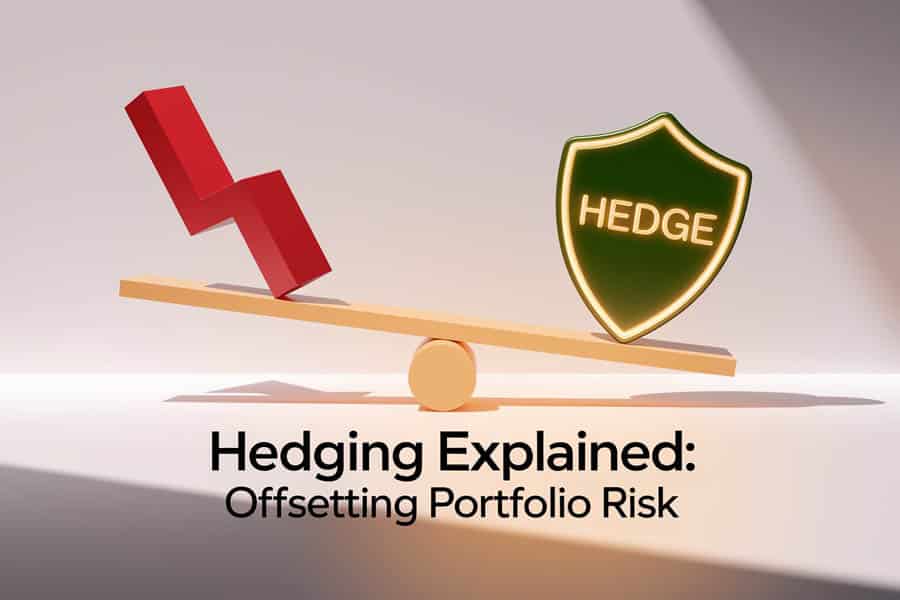Feeling uneasy about market volatility wiping out your hard-earned investment gains? It’s a common concern. Markets go up, but they also come down, sometimes sharply, leaving investors wondering how to protect their capital. Thankfully, you don’t have to just ride the rollercoaster passively. Implementing smart portfolio hedging strategies offers a way to actively manage risk and shield your investments from significant downturns, a capability often accessible even through platforms offered by your trusted online forex broker. This guide will walk you through exactly what hedging is, why it matters, and practical ways to put it to work for you.

Why and What of Hedging Explained
Let’s start with the basics. Before you can use hedging effectively, you need a clear understanding of what it involves and the problems it aims to solve. Developing sound portfolio hedging strategies begins with grasping these core concepts.

What is Portfolio Hedging?
Simply put, portfolio hedging means making specific investments designed to offset potential losses in your main portfolio or specific assets within it. Think of it as buying insurance for your investments. You pay a cost (like an insurance premium) for this protection, hoping you won’t actually need it, but securing a safety net just in case the market moves against you. The main goal of most portfolio hedging strategies is risk reduction, not necessarily hitting home runs with the hedge itself.
Why Hedge Your Portfolio?
There are several solid reasons why investors choose to hedge. A primary motivation is locking in existing profits, especially after a good run in the market when things might feel a bit overextended. Hedging can also soften the blow during expected market slumps or periods of high uncertainty, helping you sleep better at night. Exploring portfolio hedging strategies becomes relevant when you want to manage specific, identifiable risks – maybe you’re heavily invested in one sector, exposed to currency swings from international holdings, or concerned about rising interest rates – without needing to sell off your core investments.
What Risks Can Hedging Address?
Hedging isn’t a one-size-fits-all solution; different strategies target different risks. Here are some common ones that portfolio hedging strategies can help manage:
- Market Risk: This is the big one – the risk that the entire market declines due to economic, political, or other large-scale events. Hedges often involve index-based instruments.
- Sector/Industry Risk: If a large chunk of your portfolio is in, say, tech stocks, hedging can protect against issues specific to that industry.
- Interest Rate Risk: Changes in interest rates can hurt bond values and affect certain stocks. Hedging can mitigate this.
- Currency Risk: If you own international assets, fluctuations in exchange rates can impact your returns. Currency hedges address this.
- Concentration Risk: Holding too much of one stock is risky. Hedging can protect that specific position.
- Volatility Risk: Sometimes, the risk isn’t just direction, but the potential for wild price swings. Specific strategies target volatility.
Hedging vs. Diversification: Key Differences
People often mix up hedging and diversification, but they serve different roles. Diversification is about spreading your money across different types of assets (stocks, bonds, real estate, etc.) that hopefully don’t all move in the same direction at the same time. It’s a long-term, passive approach to risk reduction – don’t put all your eggs in one basket. Hedging, on the other hand, is usually a more active, often shorter-term tactic. Implementing portfolio hedging strategies involves taking a specific action (like buying a put option or shorting an ETF) designed to directly counteract a potential loss in another part of your portfolio. Diversification smooths the ride; hedging acts like a temporary insurance policy against specific negative events.
Foundational Step: Assessing Your Portfolio Risk
Before you even think about specific hedges, you need to understand what you’re trying to protect against and what you want to achieve. Skipping this crucial assessment step can render your portfolio hedging strategies ineffective or unnecessarily costly.

Identifying Your Portfolio’s Vulnerabilities
Take an honest look at your investments. Where are the potential weak spots? Do you have too much riding on one company or industry? Is your portfolio overly sensitive to overall market movements (often measured by “beta”)? Are currency fluctuations a significant factor due to international holdings? Identifying these vulnerabilities helps you focus your hedging efforts where they’re needed most. Don’t hesitate to use portfolio analysis tools or chat with a financial advisor to get a clearer picture.
Defining Your Hedging Goals
What’s the desired outcome of your hedge? Be specific. Are you aiming to prevent any loss beyond 10% over the next six months? Are you trying to protect just one large stock position against an upcoming earnings report? Or are you bracing for a potential broader market correction? Knowing your objective – whether it’s setting a hard floor on losses or just dampening volatility – guides your choice of strategy and how you structure the hedge. Clear goals lead to more effective portfolio hedging strategies.
Understanding the Cost of Hedging
Protection usually comes at a price. Hedging involves both direct costs (like transaction fees and the premiums you pay for options) and indirect or “opportunity” costs. For example, some portfolio hedging strategies limit your potential profits if the market moves favorably. If you buy protective options and the market soars, the money spent on those options is gone. You need to weigh the potential cost against the benefit of the protection offered. Is the risk you perceive significant enough to warrant the expense and potential limitations?
Core Portfolio Hedging Strategies
Let’s dive into some of the most common and accessible ways investors hedge their portfolios. These are the workhorse techniques you’re likely to encounter or consider when developing your own portfolio hedging strategies.
Read More: difference between long and short position in forex

Strategic Diversification & Asset Allocation
Although we distinguished it from active hedging earlier, smart diversification and asset allocation are your first line of defense and act as a fundamental form of risk management that has hedging effects.

How diversification acts as a basic hedge
By holding a mix of assets that tend to react differently to economic or market events (like stocks, bonds, maybe some real estate or commodities), you reduce the chance that your entire portfolio will tank simultaneously. When stocks are down, high-quality bonds might hold steady or even rise, softening the overall blow. It’s about not having all your financial eggs in one basket.
Moving beyond simple stock/bond splits
Truly effective diversification involves looking deeper than just a 60/40 stock/bond mix. Consider adding international stocks (developed and emerging markets), different types of bonds (government, corporate, varying maturities), and perhaps alternative assets known to have low correlation with traditional markets. The goal is to build a portfolio where different parts can potentially offset each other’s downturns.
Practical Angle: Reviewing and rebalancing
Markets move, and over time, your initial asset mix will drift. Regularly check if your allocation still matches your risk tolerance and goals. Rebalancing – selling some winners and buying more of the assets that have lagged – brings your portfolio back in line. This disciplined process inherently makes you sell high and buy low, contributing to risk management.
Using Protective Put Options
This is a classic hedging technique, especially popular for stock portfolio hedging strategies or protecting broad market index exposure. It involves buying put options.
How put options work to create a “floor”
A put option gives you the right (not the obligation) to sell a specific amount of an underlying asset (like 100 shares of stock or an ETF) at a set price (the strike price) before a certain date (expiration). If you own the asset and buy puts on it, you establish a minimum selling price. Should the market price fall below your strike price, the value of your put option increases, offsetting the loss on your shares below that strike. It essentially creates a safety net or price floor, minus the cost (premium) you paid for the option. This is a fundamental tool in many portfolio hedging strategies.
Step-by-step: Choosing strike price and expiration
Selecting the right put involves balancing protection and cost. A strike price close to the current market price offers more immediate protection but costs more. A strike price further below the current price is cheaper but only kicks in after a larger drop. Similarly, options with longer expirations provide protection for more extended periods but come with higher premiums. Your choice depends on how much risk you’re willing to tolerate before the protection starts, your budget, and how long you anticipate needing the hedge.
Calculating the cost and break-even point
The direct cost is the premium paid for the option contract(s). When hedging stock you own, the break-even point at expiration (where you neither make nor lose money overall compared to just holding the stock unhedged from the point you bought the put) is typically the stock’s price when you bought the put, plus the per-share cost of the put premium. For the put option itself to be profitable, the underlying asset must fall below the strike price by more than the premium paid.
Practical Angle: Hedging an S&P 500 ETF
Say you hold 100 shares of the SPY ETF, trading at $450. You’re worried about a correction in the next few months. You could buy one SPY put contract (representing 100 shares) with a $430 strike price expiring in 3 months, perhaps paying $8 per share ($800 total cost). If SPY drops to $400, your shares lose $5,000 on paper. However, your put option gives you the right to sell at $430 (or the option itself becomes valuable), largely offsetting losses below $430. Your maximum loss below $430 is limited to the $20 difference ($450-$430) plus the $8 premium, effectively setting a floor around $422 ($430 strike – $8 premium).
Employing Collars (Protective Puts + Covered Calls)
A collar is a slightly more complex options strategy that combines buying a protective put with selling a call option on the same asset. It’s often used as a way to reduce the upfront cost of hedging, making it a key technique in portfolio hedging with options.
How selling a call finances buying a put
Buying a put option costs money (you pay a premium). Selling a call option brings in money (you receive a premium). A call option gives its buyer the right to purchase your shares at a specific strike price. By selling a call option against shares you already own (this is called a “covered call”), you collect a premium. This collected premium can be used to offset, or sometimes completely cover, the cost of the protective put you buy. This results in a lower net cost (or even zero cost) for establishing downside protection compared to just buying the put outright.
Understanding the trade-off: Capped upside
Nothing comes free. The trade-off for reducing the hedging cost with a collar is that you limit your potential profit if the asset’s price goes up. By selling the call option, you’ve essentially agreed to sell your shares at the call’s strike price if the market price rises above it by expiration. Your upside gain is capped at that level. You’re giving up potential future profits above the call strike in exchange for cheaper downside protection. This trade-off is inherent in many cost-reducing portfolio hedging strategies.
Practical Angle: When a collar makes sense
A collar strategy often appeals to investors who prioritize downside protection but are willing to sacrifice potential gains beyond a certain point, mainly because they want to minimize the cash outlay for the hedge. It might be suitable if you think the asset has limited short-term upside potential anyway, or if your primary goal is capital preservation rather than maximizing gains. If reducing the cost of the hedge is a major factor, a collar is worth considering over a simple put, as long as you accept the capped upside.
Utilizing Inverse ETFs & Index Shorts
These strategies allow you to gain from or hedge against market declines without directly using options, though they come with their own set of considerations.
How inverse ETFs provide inverse exposure
Inverse ETFs are funds designed to move in the opposite direction of a specific benchmark index, usually on a daily basis. For instance, if the S&P 500 drops 1% on a given day, an inverse S&P 500 ETF aims to rise by 1% (before fees and tracking errors). Buying shares in an inverse ETF corresponding to your portfolio’s main exposure can act as a hedge. Be aware: some are leveraged (e.g., -2x or -3x), meaning they aim for double or triple the inverse daily return, which significantly magnifies both potential gains and risks.
Using short positions on index ETFs
A more direct approach is short selling a major index ETF like SPY (S&P 500), QQQ (Nasdaq 100), etc. Short selling involves borrowing shares of the ETF, selling them, hoping the price falls, then buying them back cheaper to return to the lender. The profit from a successful short sale can offset losses in your long holdings during a market dip. This requires a margin account and understanding the mechanics of shorting.
Practical Angle: Considerations and risks
Inverse ETFs, especially leveraged ones, suffer from “compounding decay” over longer periods. Because they reset daily, their long-term performance might not perfectly mirror the inverse of the index’s cumulative return. They are generally considered short-term trading tools, not ideal for long-term buy-and-hold portfolio hedging strategies. Short selling has potentially unlimited risk (a stock/ETF can theoretically rise indefinitely), incurs borrowing costs (interest), and you’re liable for any dividends paid while you’re short. Both require careful management and understanding of their unique characteristics.
Advanced & Alternative Hedging Techniques
For those with more experience, capital, and market access, several more sophisticated hedging techniques exist beyond the core strategies discussed so far. These advanced portfolio hedging strategies often involve derivatives like futures or complex option combinations.

Hedging with Futures Contracts
Large portfolios or institutional investors often use futures contracts, particularly index futures (like the E-mini S&P 500), for broad market hedging. Selling index futures creates a short market exposure; if the market falls, the futures position gains value, offsetting losses in a stock portfolio. Futures offer significant leverage, making them capital-efficient for hedging large amounts, but they demand a deep understanding of margin requirements, contract specifications, and rollover procedures.
Short Selling Individual Stocks
Instead of hedging the whole market, you might short-sell specific stocks you believe are weak or overvalued, perhaps within the same sector as some of your long holdings. The idea is that the short position’s gains could offset losses elsewhere. This carries high company-specific risk and the same potentially unlimited loss exposure as any short sale. It’s generally a strategy based on specific negative views about a company, not just general market hedging.
Pairs Trading
This is more of a market-neutral strategy than a direct portfolio hedge. It involves finding two highly correlated stocks, then going long the one that seems undervalued relative to the other, and simultaneously shorting the one that seems relatively overvalued. The goal is to profit from the expectation that their price ratio will revert to its historical mean, regardless of the overall market’s direction. It aims to isolate relative performance, thus reducing exposure to broad market moves.
Volatility Hedging
Some sophisticated traders hedge against changes in market volatility itself, often using options or futures based on the VIX index (the “fear gauge”). If you expect turbulence to increase (which often accompanies market drops), buying VIX calls or futures can pay off, potentially offsetting portfolio losses. VIX products have unique pricing behaviors (like contango and backwardation) and are complex instruments generally suited only for experienced professionals developing advanced portfolio hedging strategies.
Alternative Option Strategies
The world of options offers many other structures beyond basic puts and collars. Spreads, like put debit spreads (buying one put and selling another at a lower strike), can reduce the cost of protection but also limit the amount of protection. More complex strategies exist for various scenarios. Each requires a thorough understanding of options pricing and risk profiles.
Practical Implementation: Putting Hedging into Action
Knowing the theory is great, but successfully implementing a hedge requires careful execution. This involves selecting the right tool, getting the size right, managing the timing, and actively overseeing the position as part of your overall portfolio hedging strategies.

Choosing the Right Hedging Tool
The best tool depends entirely on what you’re hedging and why. Trying to protect against a broad market dip? Index options, collars, inverse ETFs, or even futures might fit. Worried about a single stock? Protective puts or collars on that specific stock make sense. Concerned about costs? Collars or option spreads are cheaper than outright puts. Your tolerance for complexity also matters – options and futures require more know-how than adjusting asset allocation or using simple inverse ETFs. Matching the tool to the risk is crucial for designing effective portfolio hedging strategies.
Determining the Correct Hedge Size/Ratio
How much protection do you need? You need to size your hedge appropriately to offset the potential loss you’re targeting. For options, this often involves considering the option’s delta (its sensitivity to underlying price changes) and matching the notional value (e.g., hedging $50,000 of stock might mean buying option contracts covering that amount). For inverse ETFs, calculate how many shares you need so a % gain offsets the expected % loss in your long portfolio. For futures, match the contract’s notional value to the portfolio exposure. Too small a hedge offers little protection; too large a hedge increases costs and can inadvertently create unwanted net short exposure.
Timing Your Hedge
This is often the hardest part. Ideally, you’d put a hedge on right before a drop and take it off right before the recovery. Market timing is extremely difficult in practice. Put a hedge on too early, and you rack up costs (like option premium decay) while potentially missing out on further gains. Put it on too late, and you’ve already suffered losses. Take it off too soon, and you’re exposed again if the downturn continues. Take it off too late, and you might hinder your participation in the rebound. Many use technical signals or predefined portfolio loss levels to trigger hedges, but there’s no magic formula for timing portfolio hedging strategies perfectly.
Execution: Placing Trades and Managing Positions
Once you’ve decided on the strategy, tool, size, and timing trigger, you need to place the trades via your broker. Understand the order types and the specifics of the instrument (e.g., option expiration, contract multipliers). Getting the execution right is vital. And it doesn’t end there – the hedge needs ongoing attention.
Monitoring and Adjusting Your Hedges
Hedging isn’t a ‘set-it-and-forget-it’ deal. Markets evolve, option values change daily (due to price moves, time decay, and volatility shifts), and inverse ETFs can drift from their target. You need to regularly check: Is the hedge performing as expected relative to your portfolio? How much time value is left in options? Are borrowing costs on shorts becoming excessive? Has your market outlook changed? Based on this, you might need to adjust the hedge – perhaps roll options to a later date, change strike prices, resize the position, or remove the hedge altogether. Active management is key to successful portfolio hedging strategies.
Key Considerations & Potential Pitfalls
Hedging sounds appealing, but it’s crucial to go in with your eyes open. There are costs, complexities, and risks involved in hedging itself that you need to appreciate before implementing any portfolio hedging strategies.
Read More: Risk management principles for both novice and advanced traders

The True Cost of Hedging
Think beyond just the brokerage commissions or option premiums. There are other costs: Opportunity Cost: If you hedge and the market roars higher, the money spent on premiums is gone, and strategies like collars might have capped your gains. This “cost” of missed profits can be substantial. Time Decay (Theta): Options lose value purely due to the passage of time. This is a constant headwind for long option hedges. Management Effort: Properly monitoring and adjusting hedges takes time and focus. Potential for Errors: Mistakes in implementation or management can lead to losses on the hedge itself.
Complexity and Required Knowledge
Don’t underestimate the learning curve, especially for options and futures. Understanding concepts like implied volatility and the “Greeks” (Delta, Gamma, Theta, Vega) is essential for using these tools effectively. Jumping into complex portfolio hedging with options without the necessary knowledge can be dangerous.
Timing Risk
We’ve mentioned it before, but it bears repeating: getting the timing wrong is a major pitfall. Hedging perfectly is impossible. Being too early costs money; being too late reduces effectiveness. This inherent uncertainty is a significant challenge for all portfolio hedging strategies.
Potential for Reduced Upside Returns
By its nature, hedging introduces costs or limitations that can dampen your portfolio’s overall returns, especially during strong bull markets. Consistent, long-term hedging will likely result in lower total returns compared to a similar unhedged portfolio. It’s a trade-off: potentially lower returns for potentially reduced volatility and drawdown.
The Risk of a False Sense of Security
Having a hedge in place might make you feel invincible, potentially leading you to take on more risk than you otherwise would. Remember that hedges can be imperfect, might not cover all scenarios, or could be sized incorrectly. Don’t let hedging lull you into complacency.
When Not to Hedge
Hedging isn’t always the answer. Sometimes it’s better to avoid it if: The risk seems manageable within your long-term plan and risk tolerance. The cost of the hedge seems excessive compared to the potential loss it prevents. You have a very long investment horizon and can comfortably ride out normal market fluctuations. The strategy required is too complex for your current understanding or available time. Sometimes, simply adjusting your core asset allocation (e.g., reducing stock exposure) is a simpler and more appropriate way to manage risk than complex portfolio hedging strategies.
Read More:Forex Diversification Strategies
Explore Trading Opportunities with Opofinance
As you navigate your investment journey and consider tools for managing risk or exploring different market opportunities, partnering with a capable broker is key. Opofinance, regulated by ASIC, provides a robust platform and services designed for today’s traders:
- Multiple Platform Choices: Trade your way using popular platforms like MetaTrader 4 (MT4) and MetaTrader 5 (MT5), the advanced cTrader, or Opofinance’s own intuitive OpoTrade platform.
- AI-Powered Trading Tools: Gain an edge with innovative tools including an AI Market Analyzer for deeper insights, an AI Coach for personalized feedback, and responsive AI Support.
- Community and Growth Options: Engage with social trading features or explore your potential through proprietary (prop) trading programs.
- Hassle-Free Funding: Enjoy secure and convenient deposits and withdrawals, including options for crypto payments, all with zero fees charged by Opofinance for these transactions.

Ready to enhance your trading experience? Discover what Opofinance offers today!
Integrating Hedging into Your Strategy
Ultimately, think of portfolio hedging strategies as specialized tools in your financial toolkit, not everyday necessities. Their purpose isn’t to eliminate risk entirely but to actively manage it during specific periods or against particular threats when the cost/benefit trade-off makes sense. Effective hedging is tactical and dynamic, aligning closely with your market outlook, overall financial objectives, investment horizon, and, crucially, your personal comfort level with risk and complexity. It should complement, not replace, sound long-term investment principles like diversification and appropriate asset allocation. Incorporating portfolio hedging strategies requires careful thought and planning.
Key Takeaways
- What Hedging Does: It uses offsetting investments (like options, shorts) aiming to reduce losses from unfavorable market moves.
- Start with Assessment: Understand your portfolio’s specific risks and set clear goals before choosing a hedging strategy.
- Common Methods: Protective puts offer downside floors, collars lower costs but cap gains, inverse ETFs provide opposite index exposure.
- Factor in Costs: Remember premiums, fees, potential lost upside (opportunity cost), and time decay when evaluating hedges.
- Timing is Tough: Deciding when to apply and remove a hedge is difficult and critical to its success.
- Requires Management: Hedges aren’t passive; they need monitoring and potential adjustments as conditions change.
- It’s Tactical: Hedging is usually a temporary measure for specific situations, not a permanent portfolio fixture.
- Personal Fit: Ensure any chosen portfolio hedging strategies align with your risk tolerance and overall financial plan.
Can I hedge against inflation using these strategies?
While the methods discussed primarily focus on hedging against market price declines (deflationary or recessionary risk), they aren’t direct hedges against inflation (rising price levels). Hedging against inflation typically involves holding assets expected to outperform when general prices rise, such as commodities (like gold or oil), Treasury Inflation-Protected Securities (TIPS), real estate, or stocks in sectors with pricing power. Portfolio hedging strategies like buying puts are generally designed for downside price protection, not protection against eroding purchasing power due to inflation.
How does market volatility affect the cost of hedging with options?
Market volatility, specifically “implied volatility” (the market’s expectation of future price swings), has a significant impact on option prices. Higher implied volatility makes options more expensive, both puts and calls. This means that when market fear is high and volatility spikes (often when you might most want protection), the cost of buying protective put options increases substantially. Conversely, when volatility is low, options are cheaper, but the perceived need for hedging might also be lower. This relationship is a key factor in the cost-benefit analysis of using options within portfolio hedging strategies.
Is it possible to hedge only a portion of my portfolio?
Absolutely. You don’t need to hedge your entire portfolio. Many investors choose to hedge only specific parts, such as a large concentrated stock position they don’t want to sell yet, or perhaps just the portion allocated to a specific volatile sector or geographic region (like emerging markets). You can also choose to hedge only a fraction of your total market exposure (e.g., hedging 50% of your S&P 500 exposure). This targeted approach allows you to address specific concerns without incurring the cost or complexity of hedging everything, offering flexibility in implementing portfolio hedging strategies.







